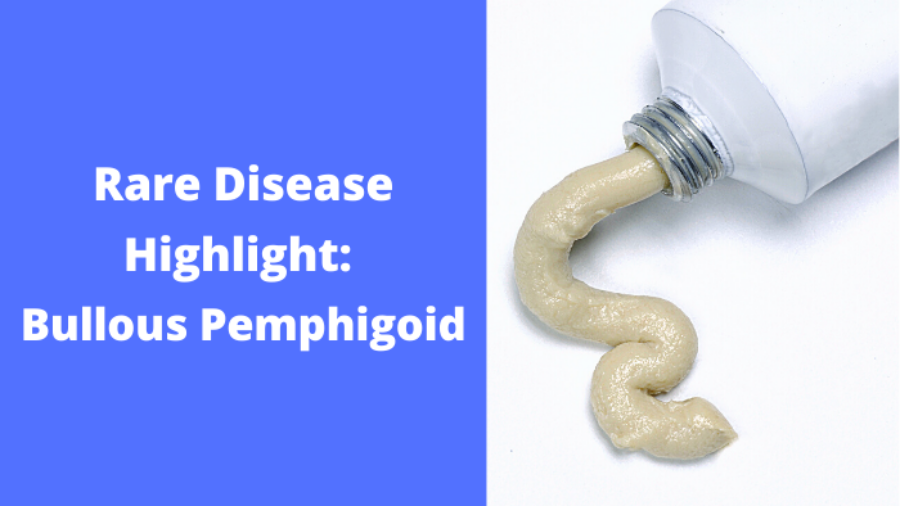Bullous pemphigoid (BP) is a rare autoimmune skin disease mainly characterized by the formation of blisters beneath the top layer of skin known as the epidermis. BP can further lead to skin that is itchy, red, swollen, and eroded, leading to severe infections. BP primarily affects individuals older than 60 years of age and has an annual incidence of 13 new cases per million in the US. Further, 312 per million people over the age of 80 are currently affected by BP in the US and Europe. [1, 2]
Although the underlying cause of BP is still unknown, immune and inflammatory responses play a role in its pathogenesis. [3] It is thought immunoglobulin G (IgG) autoantibodies, specific antibodies naturally produced by the immune system, target patients’ own proteins in the skin’s epidermal basement membrane. [1, 2] These epidermal basement membrane proteins are essential for interactions that promote adhesion of the dermal and epidermal skin layers. Once IgG autoantibodies bind to their targets, the consequential inflammatory response activates B cells, as well as various T cells and granulocytes (i.e., neutrophils and basophils). This results in the release of enzymes that damage the dermal-epidermal junction, which splits the formation between the basement membrane zone and the epidermis causing blister formation. [4, 5]
The complex interaction of predisposing and inducing factors determine the onset and progression of BP. Predisposing factors include advanced age, comorbidities, and human leukocyte antigen (HLA) genes. [6] HLA genes are the most significant genetic factor in autoimmunity mechanisms, with many studies identifying a link between HLA-DQβ1*0301 and clinical pemphigoid; BP is a subtype of pemphigoid. Inducing factors include drug use, infections, and physical triggers. [2] Overall, inducing factors for BP in genetically predisposed individuals are numerous and have been identified in approximately 15% of patients. [6]
Diagnosis of BP relies on the clinical picture and laboratory tests. Clinical features suggestive of BP include itchy skin, rash, hive lesions, and tense blisters with clear fluid. [7] Direct immunofluorescence (DIF) is the most reliable and sensitive diagnostic test, which involves direct detection of tissue bound autoantibodies by analyzing a biopsy. However, nonspecific staining may be seen in other skin disorders with occasional false-positive findings. [8] Non-direct immunofluorescence, such as enzyme-linked immunoassay (ELISA), are also used in combination with DIF to diagnose BP. [2]
The current treatment of BP primarily consists of corticosteroids. The combination of topical and oral corticosteroids is the most common treatment strategy. The goals of treatment are to minimize the use of oral corticosteroids as early as possible and to maintain remission. Minimization of oral corticosteroid use is important because this drug class is associated with various adverse reactions such as fluid retention, weight increase, hypertension, diabetes mellitus, peptic ulcer, osteoporosis, and cataract. Such adverse reactions are more likely to occur in the elderly, thus requiring more cautious use in these patients. Alternative agents include azathioprine, mycophenolate mofetil, methotrexate, and cyclophosphamide. [2] Notably, treatment with systemic steroids and alternative agents have shown no improvement in disease control. [3] Thus, there is a high unmet medical need for new efficacious and safe anti-inflammatory drugs for the BP patient population to avoid corticosteroid therapy that requires advanced management by specialists.
References used
1. Kridin, K. and R.J. Ludwig, The Growing Incidence of Bullous Pemphigoid: Overview and Potential Explanations. Front Med (Lausanne), 2018. 5: p. 220.
2. Baigrie, D. and V. Nookala, Bullous Pemphigoid, in StatPearls. 2022, StatPearls Publishing Copyright © 2022, StatPearls Publishing LLC.: Treasure Island (FL).
3. Miyamoto, D., et al., Bullous pemphigoid. An Bras Dermatol, 2019. 94(2): p. 133-146.
4. Genovese, G., et al., New Insights Into the Pathogenesis of Bullous Pemphigoid: 2019 Update. Front Immunol, 2019. 10: p. 1506.
5. Kubin, M.E., L. Hellberg, and R. Palatsi, Glucocorticoids: The mode of action in bullous pemphigoid. Exp Dermatol, 2017. 26(12): p. 1253-1260.
6. Lo Schiavo, A., et al., Bullous pemphigoid: etiology, pathogenesis, and inducing factors: facts and controversies. Clin Dermatol, 2013. 31(4): p. 391-399.
7. Gaufin, M. and C.M. Hull. Bullous Pemphigoid Rare Disease Database 2018 [cited 2022 Janurary 23, 2022]; Available from: https://rarediseases.org/rare-diseases/bullous-pemphigoid/.
8. Di Lernia, V., et al., Pemphigus Vulgaris and Bullous Pemphigoid: Update on Diagnosis and Treatment. Dermatol Pract Concept, 2020. 10(3): p. e2020050.
BioPharma Global is a mission-driven corporation dedicated to using our FDA and EMA regulatory expertise and knowledge of various therapeutic areas to help drug developers advance treatments for the disease communities with a unmet medical needs. If you are a drug developer seeking regulatory support for Orphan Drug designation, Fast Track designation, Breakthrough Therapy designation, other FDA/EMA expedited programs, type A, B (pre-IND, EOPs), or C meeting assistance, or IND filings, the BioPharma Global team can help. Contact us today to arrange a 30-minute introductory call.
Stock image by John McAllister from Depositphotos

